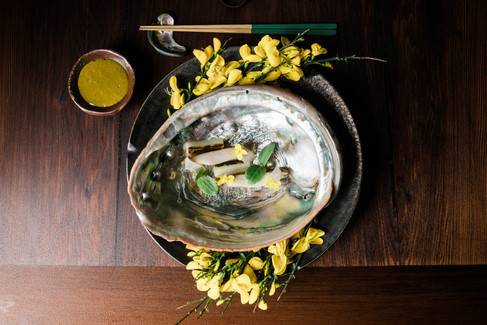The Taste of Mendocino: Elk’s Harbor House & Greenwood Restaurant
- janna225
- May 29
- 4 min read
Updated: Jun 5
Article by Christina Mueller | Photos by Wray Sinclair, Joseph Weaver, Matt Morris, Adrian Rudd, Jesse Cudworth | Published May 29, 2025

What does Mendocino taste like? If pressed to define the essence of this rugged scrap of land in California’s northern reaches, do your senses evoke cypress and bay trees? Cow manure? Fog and salt water? Mendocino, two counties and about 190 miles north of San Francisco, is chillier and wetter than much of California. Unlike California’s desert regions, the Northern California county where the towns of Mendocino and Elk are located boasts a climate tempered by fog and rain, leavened with coastal sunshine that warms the spirit rather than pounding it into submission.
Photos: Joseph Weaver Photography
Spring’s Bounty, In Winter
This climatic distinction is not lost on Chef Matt Kammerer of Elk’s Harbor House, a Michelin two-star restaurant and Michelin one-key resort. Unlike nearby Anderson Valley, the western end of which is about 10 minutes east of Elk, the coastal town and surrounding region do not suffer winter’s freeze. That and their geographic coordinates (Latitude: 39.130317, Longitude: -123.717314, to be precise) provide a steady amount of daylight and temperature, no matter the season. “We mimic fall or winter in the middle of spring or summer,” Kammerer says. Here, field pea plants are a suitable winter cover crop, their fruit – so-called spring peas – a beneficial side product harvested in January or, March, or November. “Plants don’t know the calendar,” Kammerer says.
Photos: Matt Morris
Topsy-turvy produce seasons create opportunities for Kammerer and his team. Black trumpet mushrooms, foraged from the forest behind the restaurant, are part of winter’s harvest, the coastal damp and dappled sunlight fostering a fungal bounty. It’s a dish’s starting point. Ripped into strips, the mushrooms are atomized in the pan to maximize their essential character. Burdock from the restaurant’s nearby garden is grilled until golden. Citrus from Mendocino’s banana belt a few miles south adds zip. Cod smoked over bay laurel leaves brings meatiness. Those “out of season” field peas? A perfect match, its fruit, tendrils, and flowers taking the dish someplace new. The textures and flavors of the dish are Kammerer’s and his crew’s. The taste? That’s Mendocino. “We put the place on the plate,” Kammerer says. “It’s the minute details that make a singular experience.”
Redefining Luxury
Like Kammerer at Harbor House, Chef Ryan Seal at nearby Greenwood Restaurant does not follow a caviar + Wagyu + lobster formula for luxury dining experiences. Seal came to Mendocino to pursue the qualities of what he calls the region’s unique originality. “There’s a blend here of artists and farmers, tradesmen and sculptors, and a focus on nature and the old way of doing things,” Seal says. “It’s inspiring.”
Seal and I discussed his Uni Carbonara. Foundational to the dish is sea urchin sourced from nearby Noyo Harbor and sea vegetables pulled from Mendocino’s waters. Seal and his team make sabayon from the urchin and dashi from Mendocino-grown nori and kombu, building flavor with Japanese-sourced katsuobushi and taming the uni with Sonoma-sourced bacon. The Mendocino Grain Project supplies semolina for the restaurant’s house-made bucatini. “Close your eyes and taste the ocean,” Seal urges. “It’s an oceanesque (sic) dish made with ingredients endemic to Mendocino.”

California’s Coastal Cuisine Considerations
The idea of California Coastal cuisine has emerged in Mendocino and other pacific-hugging regions of the Golden State, an off-shoot of California Cuisine that shares a focus on local and sustainable ingredients with further attention to the region’s layered seasonality. Chefs like Seal and Kammerer lean into the idea that California Coastal requires feeling the force of the earth coming through in each dish. The intertidal zone where many sea vegetables thrive – above water level at low tide and underwater at high tide – captures Mendocino’s earthy, saltwater essences that, like fog, further impact Mendocino’s landscapes.
Chefs like Kammerer and Seal honor the craft of artisans worldwide, incorporating global ingredients to enhance local flavor. Kammerer, with exceptions like French Burgundy or white soy sauce and aged tamari from Japan, sources most ingredients on his menu within 30 minutes of the restaurant. That timing aspect of sourcing from his backyard is part of the Mendocino experience. Whether he is working with purple cress, miner’s lettuce, or fresh Douglas Fir tips, it’s been picked that day for incomparable flavor on the plate. “We do 20 covers a night,” Kammerer says. “It’s product plus timing and it’s really hard to do if you’re doing 60 to 80 covers a night. We start from scratch every day.”
Photos: Jesse Cudworth
Dinner at Harbor House includes a final dessert of eight bites. The show’s star is a Douglas Fir herbal infusion, a tea as aromatic as the redwoods outside. A fennel stick wrapped with herbs and flowers serves as accouterment. Kammerer gently smokes the flower stick, adding its perfume to the air. Place it and a spoonful of local honey in the infusion and head out back. Two fires will be burning. No light pollution means epic views of the Milky Way accompanied by the crash of surf just below the cliffs. That’s Mendocino.
Chef Seal says it best: “When you eat here, it should taste like it comes from here. That experience creates a connection to this place. It’s the ocean and the trees and the whole experience. It’s difficult to translate.”
Editor’s Note: Since the time of reporting and publication, Greenwood Restaurant has permanently closed. We’ve chosen to keep this story live to honor the people, place, and culinary creativity it captured at the time.

































